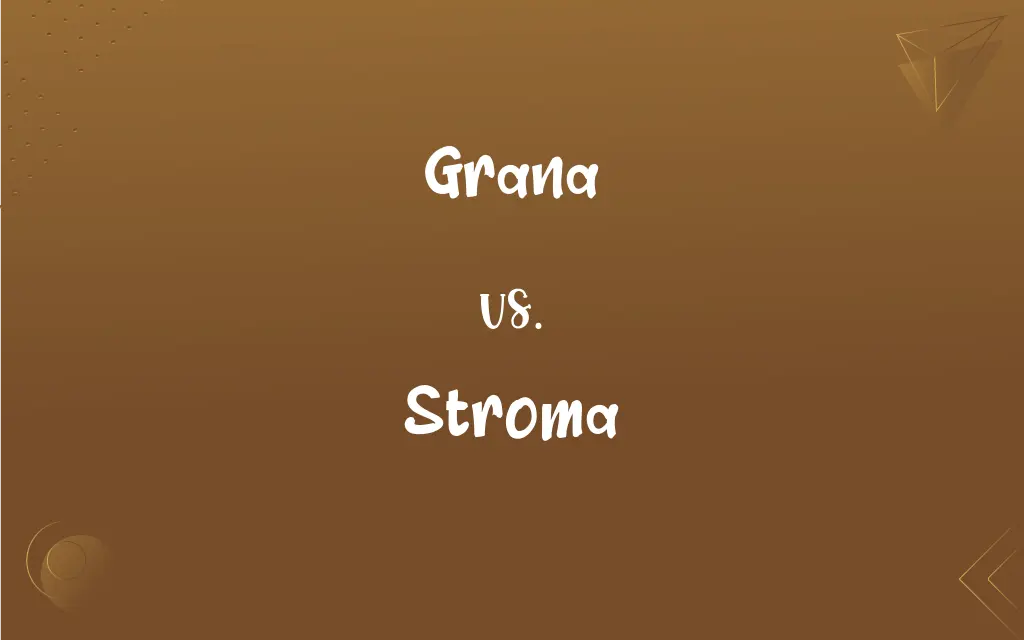Grana vs. Stroma: What's the Difference?
Edited by Janet White || By Harlon Moss || Updated on October 26, 2023
Grana are stacks of thylakoid membranes in chloroplasts, while stroma is the fluid-filled matrix of the chloroplast surrounding grana.

Key Differences
Grana are structures within chloroplasts composed of stacked thylakoid membranes. These stacks are where the light-dependent reactions of photosynthesis occur. Stroma: The stroma is the gel-like substance in chloroplasts that surrounds the grana and is where the light-independent reactions, or the Calvin cycle, takes place.
The primary role of grana is to capture and convert light energy during photosynthesis. They contain chlorophyll and other pigments that absorb sunlight. Stroma: On the other hand, stroma houses the enzymes necessary for the synthesis of glucose and other sugars.
Grana's physical appearance is like stacks of coins, with each "coin" being a thylakoid membrane. Stroma: The stroma, however, lacks such a defined structure and appears as a viscous fluid.
The efficiency of photosynthesis is enhanced by the tight packing of thylakoid membranes in grana. Stroma: In contrast, the stroma provides the necessary environment for the enzymatic reactions involved in carbohydrate synthesis.
Without grana, the plant couldn't effectively capture sunlight. Stroma: Without the stroma, the plant wouldn't be able to convert that captured energy into usable sugars.
ADVERTISEMENT
Comparison Chart
Primary Function
Site for light-dependent reactions.
Site for light-independent reactions (Calvin cycle).
Appearance
Stacked thylakoid membranes (like coins).
Fluid-filled matrix.
Content
Contains chlorophyll for photosynthesis.
Contains enzymes for carbohydrate synthesis.
Role in Photosynthesis
Captures and converts light energy.
Synthesizes glucose and other sugars.
Structural Importance
Essential for sunlight absorption.
Provides environment for enzymatic reactions.
ADVERTISEMENT
Grana and Stroma Definitions
Grana
Structures containing chlorophyll.
Light is absorbed by the chlorophyll within the grana.
Stroma
Contains enzymes for carbohydrate synthesis.
Enzymes within the stroma facilitate the production of glucose.
Grana
Sites for light-dependent reactions in photosynthesis.
Without grana, the initial stages of photosynthesis wouldn't occur.
Stroma
Provides an environment for enzymatic reactions.
The consistency of the stroma allows for various chemical reactions to occur.
Grana
Tightly packed to enhance photosynthetic efficiency.
The dense arrangement of the grana ensures maximum light absorption.
Stroma
The fluid matrix of chloroplasts.
The stroma surrounds the grana within the chloroplast.
Grana
Stacks of thylakoid membranes in chloroplasts.
The grana are crucial for capturing sunlight during photosynthesis.
Stroma
Site for the Calvin cycle in photosynthesis.
The light-independent reactions take place in the stroma.
Grana
Essential components of plant chloroplasts.
Grana work in conjunction with stroma in the photosynthetic process.
Stroma
Essential for converting energy during photosynthesis.
The stroma processes the energy captured by the grana.
Grana
Plural of granum.
Stroma
The connective tissue framework of an organ, gland, or other structure, as distinguished from the tissues performing the special function of the organ or part.
Grana
Plural of granum
FAQs
What gives grana their green color?
The chlorophyll present in the grana gives them their green color.
What are grana?
Grana are stacks of thylakoid membranes found in chloroplasts.
Where do light-dependent reactions occur?
They occur in the grana of chloroplasts.
Do grana contain DNA?
Yes, grana are part of chloroplasts which contain their own DNA.
What is the stroma?
Stroma is the fluid-filled matrix in chloroplasts that surrounds the grana.
What would happen if a plant lacked grana?
Without grana, the plant couldn't effectively capture and convert sunlight during photosynthesis.
How are grana and stroma interconnected?
Grana are embedded in the stroma, and they collaboratively facilitate photosynthesis.
Why is the stroma important?
The stroma is crucial for converting captured energy into sugars and other molecules during photosynthesis.
Can photosynthesis occur without grana?
No, grana are essential for the light-dependent stage of photosynthesis.
What role does the stroma play in the Calvin cycle?
The stroma provides the environment and enzymes for the reactions of the Calvin cycle.
Do grana have a specific number of thylakoid stacks?
No, the number of thylakoid stacks in grana can vary.
Is the composition of the stroma consistent among different plants?
While the basic components of the stroma are similar among different plants, specific concentrations of enzymes, organic acids, and other molecules may vary depending on the plant species and its environmental conditions.
And where do light-independent reactions take place?
In the stroma of chloroplasts.
How does the stroma appear?
The stroma appears as a viscous, fluid-filled matrix.
What are the main components found in the stroma?
The stroma contains enzymes, sugars, organic acids, and other molecules.
Can the stroma help in ATP synthesis?
Yes, ATP synthesis occurs in the stroma during the light-independent reactions of photosynthesis.
Do grana float freely in the stroma?
No, grana are embedded within the stroma of the chloroplast.
Are grana unique to plants?
No, grana are also found in algae and certain other photosynthetic organisms.
Is the Calvin cycle associated with the grana?
No, the Calvin cycle occurs in the stroma.
What's the physical appearance of grana?
Grana appear like stacked coins, each being a thylakoid membrane.
About Author
Written by
Harlon MossHarlon is a seasoned quality moderator and accomplished content writer for Difference Wiki. An alumnus of the prestigious University of California, he earned his degree in Computer Science. Leveraging his academic background, Harlon brings a meticulous and informed perspective to his work, ensuring content accuracy and excellence.
Edited by
Janet WhiteJanet White has been an esteemed writer and blogger for Difference Wiki. Holding a Master's degree in Science and Medical Journalism from the prestigious Boston University, she has consistently demonstrated her expertise and passion for her field. When she's not immersed in her work, Janet relishes her time exercising, delving into a good book, and cherishing moments with friends and family.































































